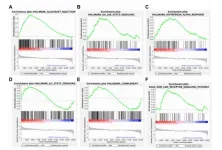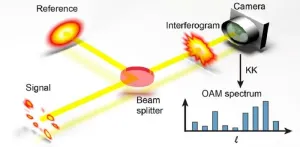(Press-News.org) New guidance published in Anaesthesia (the journal of the Association of Anaesthetists) provides clear advice to reduce avoidable errors on all steps of the pathway involving injectable medications used routinely in anaesthesia care. The guidance has been written by a working party of UK anaesthesia experts that include Dr Mike Kinsella, Honorary Consultant, Department of Anaesthesia, University Hospitals Bristol and Weston, Bristol, UK and Chair of the Working Party.
The authors explain: “Peri-operative medication safety is complex. Avoidance of medication errors is both system- and practitioner-based, and many departments within the hospital contribute to safe and effective systems. For the individual anaesthetist, drawing up, labelling and then the correct administration of medications are key components. These guidelines aim to provide pragmatic safety steps for the practitioner and other individuals within the operative environment, as well as short- to long-term goals for development of a collaborative approach to reducing errors. The aim is that they will be used as a basis for instilling good practice.”
This guidance has been produced by the Association of Anaesthetists in response to requests from members in view of continuing incidents of medication errors and patient harm. It ties in with the World Health Organization (WHO) 3rd Global Patient Safety Challenge `Medication Without Harm´, which was the theme of the WHO World Patient Safety Day September 2022.
Among other things, the importance, utility and enhanced safety offered by prefilled and labelled medication syringes is emphasised, as well as the use of aids such as colour-coded medication trays that can help the anaesthetist correctly organise the syringes before and during anaesthesia. Neither prefilled syringes nor these coloured aids are yet in widespread use in the UK NHS.
The authors say that labelling errors have been noted in around 1–1.25% of peri-operative medication administrations and medication substitutions in 0.2% of administrations during anaesthesia, although precise figures are lacking as research studies use different methodologies. It is important to acknowledge that every practitioner is open to error and that the risk can increase over time during a case, especially in the presence of specific factors that diminish performance such as fatigue.
The authors say: “Understandably, there is considerable emphasis on medication errors. However, it is also important to give appropriate recognition to the fact that in virtually all cases the correct medication is given by the correct route, at the correct time. Good practice should be highlighted; in most cases there is a consensus on what this looks like.”
The summary recommendations of the Guidelines are as follows:
1 Safe handling of medicines requires clear institutional policy within multiple departments as well as careful individual practice.
2 Departments of anaesthesia should have policies for safe handling of medicines.
3 Pharmacy departments should promote purchasing for safety, consistent supply and purchase from those companies complying with good labelling practice
4 Prefilled syringes have multiple advantages, and their purchase and use should be promoted.
5 Standardisation of fit-for-purpose physical structure and medicine storage in workplaces should be developed.
6 Technological solutions that reduce the opportunity for error should be explored and adopted whenever possible.
7 Standardisation of practice for syringe labelling and handling should be promoted and should form part of the curriculum for training anaesthetists. This should reduce the risk of errors when anaesthetists work together.
8 Individual anaesthetists may have characteristics that affect their working; these should be recognised by the individual as well as their department, and suitable adjustments to practice made.
The authors say: “’First do no harm’ is what doctors strive for. We hope that these guidelines provide useful points for anaesthetists’ individual practice, while acknowledging that patient safety also relies on supportive systems within their hospitals.”
For full embargoed paper, click here
NOTE: THE ABOVE LINK IS FOR JOURNALISTS ONLY. IF YOU WISH TO PROVIDE A LINK TO THIS PAPER FOR YOUR READERS, PLEASE USE THE FOLLOWING, WHICH WILL GO LIVE WHEN THE EMBARGO LIFTS:
https://doi.org/10.1111/anae.16095
For links to photos of prelabelled, prefilled syringes that you can use in your stories, click here
For photos of rainbow tray aids, click here and here
Please credit Dr Mike Kinsella when using the images
END
New guidance on safe injection practice in hospitals emphasises the importance of prefilled and labelled syringes in avoiding medication errors
2023-08-09
ELSE PRESS RELEASES FROM THIS DATE:
Health experts urge clinicians to ‘remain vigilant’ about malaria cases in new commentary
2023-08-08
FOR IMMEDIATE RELEASE
Tuesday, August 8, 2023
Contact:
Michael Saunders, msaunder@bu.edu
Jillian McKoy, jpmckoy@bu.edu
##
As worsening climate change and increased global travel create ideal conditions for a resurgence of malaria in areas where it has long been eradicated, clinicians must be vigilant of the disease’s symptoms and act swiftly once cases are detected, health experts warn in a new commentary published in the Annals of Internal Medicine.
In the last few months, Florida and Texas have reported ...
Inflammation slows malaria parasite growth and reproduction in the body
2023-08-08
Research led by the Peter Doherty Institute for Infection and Immunity (Doherty Institute) and the Kirby Institute found that inflammation in the body can slow down the development of malaria parasites in the bloodstream – a discovery that may constitute a potential new strategy for preventing or limiting severe disease.
A mosquito-borne disease, malaria is caused by Plasmodium parasites, which invade and multiply within red blood cells. Previous research has shown that the parasites can rapidly sense and respond to conditions within the host by intimately syncing with their internal body clocks. While it is known that the body’s nutrient levels and daily circadian rhythms affect ...
Mothers experiencing depression can still thrive as parents
2023-08-08
The proverb “It takes a village to raise a child” takes on new significance when a mother of a child is experiencing depression.
“Being a mother with depression carries increased risks for a child’s physical and psychological health,” says Dr. Sarah Dow-Fleisner, Assistant Professor in the School of Social Work and Director of the Centre for the Study of Services to Children and Families at UBC Okanagan. “But it’s not fated to be, especially if mothers have external supports.”
Dr. Dow-Fleisner’s findings, recently published in the ...
Prestigious NSF grants awarded to UTEP early-career faculty
2023-08-08
EL PASO, Texas (Aug. 8, 2023) – Two University of Texas at El Paso researchers have earned one of the nation’s highest awards for early-career faculty in 2023.
Laura Alvarez, Ph.D., an assistant professor in the Department of Earth, Environmental and Resource Sciences, received a $550,000 grant from the National Science Foundation’s (NSF) Faculty Early Career Development (CAREER) Program. The funds will support her research in understanding how river landscapes and their ecological and economic values such as hydroelectric ...
AIBS receives NSF Award to convene discussions on building an integrated, open, FAIR data network
2023-08-08
The American Institute of Biological Sciences (AIBS) has been awarded a workshop grant (Award No. 2303588) from the National Science Foundation (NSF) to support the development of a series of discussions on enabling interdisciplinary and collaborative science through the integration of biological and environmental data. AIBS, in collaboration with the Biodiversity Collections Network (BCoN), will organize a set of domain-focused virtual listening sessions and a subsequent interdisciplinary workshop to engage an expansive set of stakeholders toward Building an Integrated, Open, Findable, Accessible, Interoperable, and Reusable (BIOFAIR) Data Network.
During the last two decades, a wealth ...
UTHealth Houston researcher awarded $3.1M NIH grant to study sudden unexpected death in epilepsy
2023-08-08
A five-year, $3.1 million grant to study preventive strategies for sudden unexpected death in epilepsy (SUDEP) has been awarded to UTHealth Houston by the National Institutes of Health (NIH) National Institute of Neurological Disorders and Stroke.
Nuria Lacuey Lecumberri, MD, PhD, associate professor in the Department of Neurology with McGovern Medical School at UTHealth Houston, is principal investigator of the study, which builds upon her years of research analyzing breathing during epileptic seizures and the localization of brain areas involved in breathing regulation.
SUDEP is a devastating ...
Sustainable Cocoa Innovation Challenge for Colombia: Supporting innovation in the cocoa value chain to foster climate change mitigation and peacebuilding
2023-08-08
Bogotá, 04 August 2023. The Sustainable Cocoa Innovation Challenge for Colombia has been launched as the result of the joint effort between CGIAR research initiatives AgriLAC Resiliente and Mitigate+ and the project “Implementing Sustainable Agricultural and Livestock Systems for Simultaneous Targeting of Forest Conservation for Climate Change Mitigation (REDD+) and Peacebuilding in Colombia,” otherwise known as the IKI-SLUS Project.
The CGIAR Accelerate for Impact ...
Inhibiting NLRP3 signaling in aging podocytes improves longevity
2023-08-08
“Together, these results suggest a critical role for the NLRP3 inflammasome in podocyte and liver aging.”
BUFFALO, NY- August 8, 2023 – A new research paper was published in Aging (listed by MEDLINE/PubMed as "Aging (Albany NY)" and "Aging-US" by Web of Science) Volume 15, Issue 14, entitled, “Inhibiting NLRP3 signaling in aging podocytes improves their life- and health-span.”
The decrease in the podocyte’s lifespan and health-span that typify healthy kidney aging cause a decrease in their normal structure, physiology and function. The ability to halt and even reverse these changes becomes clinically relevant ...
New technique measures structured light in a single shot
2023-08-08
Structured light waves with spiral phase fronts carry orbital angular momentum (OAM), attributed to the rotational motion of photons. Recently, scientists have been using light waves with OAM, and these special "helical" light beams have become very important in various advanced technologies like communication, imaging, and quantum information processing. In these technologies, it's crucial to know the exact structure of these special light beams. However, this has proven to be quite tricky.
Interferometry ...
Study: Vaccination campaign in Cambodia protects endangered wild cattle from highly contagious potentially fatal skin disease
2023-08-08
Scientists from the Wildlife Conservation Society (WCS), the Ministry of Environment, and the Ministry of Agriculture Forestry and Fisheries of the Royal Government of Cambodia have documented the first case of lumpy skin disease (LSD) in wildlife in Cambodia.
The case involved a banteng (Bos javanicus), an endangered wild cattle species, that was discovered by community patrol members from Our Future Organization while on patrol in Phnom Tnout – Phnom Pork Wildlife Sanctuary in September 2021.
It is suspected that the banteng contracted ...





